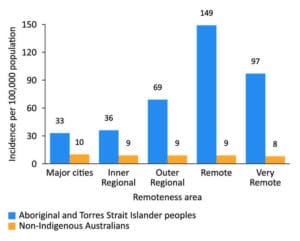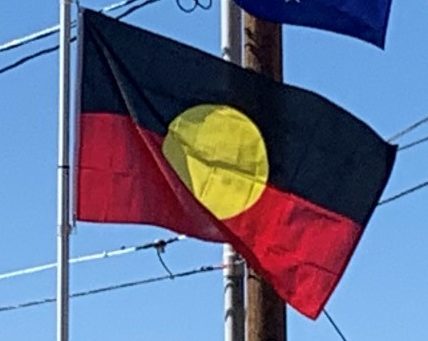
The incidence rate of cancer was lower in Aboriginal Australians than non-Aboriginal Australians in 2005–2009. However, some cancers, including lung cancer and liver cancer, were significantly more common in Aboriginal people. The overall mortality rate of Aboriginal Australians due to cancer was 1.3 times higher than non-Aboriginals in 2013. This may be because they are less likely to receive the necessary treatments in time, or because the cancers that they tend to develop are often more lethal than other cancers.
Tobacco Usage:
According to the Australian Bureau of Statistics, a large number of Aboriginal Australians use tobacco, perhaps 41% of people aged 15 and up. This number has declined in recent years, but remains relatively high. The smoking rate is roughly equal for men and women across all age groups, but the smoking rate is much higher in rural than in urban areas. The prevalence of smoking exacerbates existing health problems such as cardiovascular diseases and cancer. The Australian government has encouraged its citizens, both Aboriginal and non-Aboriginal, to stop smoking or to not start.

Alcohol Usage:
In the Northern Territory (which has the greatest proportion of Aboriginal Australians), per capita alcohol consumption for adults is 1.5 times the national average. Nearly half of Aboriginal adults in the Northern Territory reported alcohol usage. In addition to the inherent risks associated with alcohol use, its consumption also tends to increase domestic violence. Aboriginal people account for 60% of the facial fracture victims in the Northern Territory, though they only constitute approximately 30% of its population. Due to the complex nature of the alcohol and domestic violence issue in the Northern Territory, proposed solutions are contentious. However, there has recently been increased media attention to this problem.

Diet:
Modern Aboriginal Australians living in rural areas tend to have nutritionally poor diets, where higher food costs drive people to consume cheaper, lower quality foods. The average diet is high in refined carbohydrates and salt, and low in fruit and vegetables. There are several challenges in improving diets for Aboriginal Australians, such as shorter shelf lives of fresh foods, resistance to changing existing consumption habits, and disagreements on how to implement changes. Some suggest the use of taxes on unhealthy foods and beverages to discourage their consumption, but this approach is questionable. Providing subsidies for healthy foods has proven effective in other countries, but has yet to be proven useful for Aboriginal Australians specifically.
Aboriginal Australian People Groups and Tribes:
Dispersing across the Australian continent over time, the ancient people expanded and differentiated into distinct groups, each with its own language and culture. More than 400 distinct Australian Aboriginal peoples have been identified, distinguished by names designating their ancestral languages, dialects, or distinctive speech patterns. Historically, these groups lived in three main cultural areas, the Northern, Southern, and Central cultural areas. The Northern and Southern areas, having richer natural marine and woodland resources, were more densely populated than the Central area.
